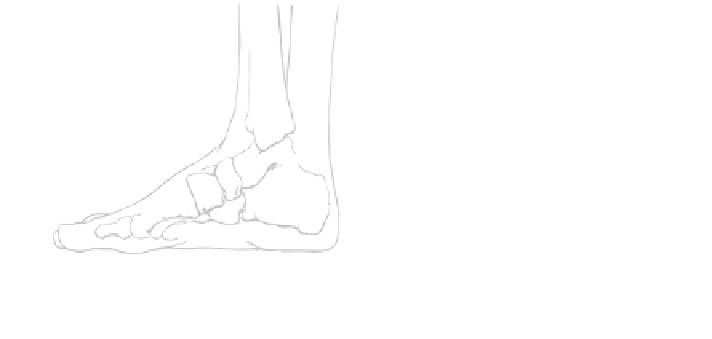Biomedical Engineering Reference
In-Depth Information
Fig. 2
The truss and tie-bar mechanisms as described by Hicks (adapted from Stainsby [
24
],
p. 60)
[
18
,
21
]. This mechanical arrangement provides the ability for the arch-like
structure of the foot to flatten during weight bearing and to reappear when the foot
is unloaded. When the plantar aponeurosis is severed, the arch raising function of
the foot is almost non-existent [
22
]. Furthermore, the plantar aponeurosis acts as a
sling underneath the metatarsal heads in order to assist in dissipating plantar
pressures [
23
]. The main function of the combined longitudinal arch, particularly
the medial component, is to help absorb and dissipate the ground reaction forces
generated with each step during gait [
1
,
19
].
The foot is able to support and absorb very high loads. During walking, the
peak vertical forces acting on the foot can reach up to 150 % of body weight [
25
].
When walking 1.6 km (1 mile), an individual weighing 67 kg has been estimated
to cumulatively absorb 64.5 tonnes on each foot [
26
]. As a consequence of having
to consistently withstand such high loading, foot pathologies frequently occur. For
example, increased stress or pressure on the metatarsal heads may cause pain and
discomfort. A tight Achilles tendon has also been known to increase forefoot
loading in the stance phase of gait, resulting in stress on the metatarsal heads [
27
].
High pressures on the forefoot have also been linked to arch collapse and have
been documented in diabetic patients [
28
].
To minimise the potential for developing foot pathologies, the foot absorbs
shock in two main ways. Firstly, two specialised fat pads beneath the metatarsal
head and heel region on the plantar aspect of the foot directly absorb and dissipate
the forces exerted on the feet when standing and during dynamic tasks [
29
]. These
two pads consist of fat filled micro-chambers encapsulated in fibroelastic tissue
[
30
,
31
]. Throughout these chambers are vibration sensitive Pacinian corpuscles
[
32
]. The function and mobility of the plantar fat pads have not been well docu-
mented, although the importance of the metatarsal head fat pad in reducing
pressure has been shown in neuropathic feet with ulceration, evident by a shift in
the metatarsal head fat pad [
33
,
34
]. In some adults a fat pad also exists in the
lateral midfoot region, although the reasoning behind this occurrence is currently
unknown.





































































































































Search WWH ::

Custom Search